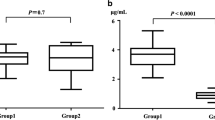Summary
Sisomicin is a new aminoglycoside which closely resembles gentamicin in antimicrobial activity, pharmacology, clinical efficacy, and toxicity. It is more active in vitro against Pseudomonas aeruginosa and indole-positive Proteus than other aminoglycosides. Twenty-five neonates with serious systemic infections were treated. Bacteriologic cultures were made in all cases to confirm the diagnosis and the type of organism. Antibiotic serum concentrations were performed during the first three days of treatment. Sisomicin was administered i.m. at a dosage of 4 mg/kg/day in divided doses every 12 hours for a period of 7 to 10 days. Sixteen patients (64 %) presented a complete regression of symptoms. There was a marked improvement in two patients (8 %). The treatment did not alter the clinical condition in three cases (12 %). The local and systemic tolerance of the antibiotic was good. This limited experience suggests that sisomicin is an effective antibiotic for treatment of susceptible gram-negative bacterial infections in the neonatal period.
Zusammenfassung
Sisomicin ist ein neues Aminoglykosid, welches dem Gentamicin in der antimikrobiellen Wirkung, Pharmakologie, klinischen Wirksamkeit und Toxizität ähnlich ist. Sisomicin ist in vitro gegen Pseudomonas aeruginosa und indolpositive Proteus wirksamer als andere Aminoglykoside. Es wurden 25 Neugeborene mit schweren systemischen Infektionen behandelt. Bakterienkulturen wurden in allen Fällen angelegt, um die Diagnose zu bestätigen und die Art des Erregers festzustellen. Während der ersten 3 Behandlungstage wurden Serumkonzentrationen bestimmt. Sisomicin (4 mg/kg täglich) wurde intramuskulär in 2 Einzeldosen alle 12 Stunden über einen Zeitraum von 7 bis 10 Tagen verabreicht. Bei 16 Patienten (64 %) gingen die Symptome vollständig zurück. Eine deutliche Besserung konnte in 2 Fällen verzeichnet werden (8 %). Bei 3 Patienten veränderte sich das klinische Bild nicht (12 %). Das Antibiotikum wurde lokal und systemisch gut vertragen. Die aus dieser Studie gewonnenen Erfahrungen zeigen, daß Sisomicin ein wirksames Antibiotikum ist zur Behandlung von bakteriellen Infektionen in der Neonatalperiode hervorgerufen durch empfindliche gramnegative Erreger.
Similar content being viewed by others
Literatur
Eickoff, T., Klin, J. C., Daly, D., Ingall, L., Finland, M. Neonatal sepsis and other infections due to group B hemolytic streptococci. N. Engl. J. Md. 27 (1964) 1221–1228.
Buetow, K. C., Klein, S. W., Lane, R. B. Septicemia in premature infants. Amer. J. Dis. Child. 110 (1965) 29–41.
Gluck, L., Wood, H. F., Fousek, M. D. Septicemia of the newborn. Ped. Clin. N. Amer. 13 (1966) 1131–1148.
Myhan, W., Fosek, M. Septicemia of the newborn. Pediatrics. 22 (1958) 268–278.
Heredia, A., Melgoza, H. Doscientos setenta y siete casos con septicemia en El Hosp. Inf. Mex. Bol. H. Inf. Mex. 24 (1967) 647–654.
Investigator's Brochure: Informational material for the investigational drug sisomicin. Schering Corporation, Bloomfield (New Jersey) 1972.
Crowe, C. C., Sanders, E. Sisomicin: Evaluation in vitro and comparison with gentamicin and tobramycin. J. Antimicrob. Ag. Chemother. 3 (1973) 24–28.
Cooper, D., Jaret, R. S., Reimann, H. Structure of sisomicin a novel unsaturated aminoglycoside antibiotic from Micromonospora inyoensis. J. Organic Chemistry. 39 (1974) 1451–1457.
Klein, J. Consideration of Gentamicin for therapy of neonatal sepsis. J. Infect. Dis. 119 (1969) 457–459.
Grove, D. C., Randall, W. A. Assay Method of antibiotics: A laboratory manual. Medical Enclyclopedia, New York 1975.
Escarzaga, E., Hills, S., Esquivel, H. C., Herra, S. C., Gonzales, S. M.: Niveles hematicos de sisomicina en niños recien nacidos. In press.
Welling, P. C., Mosegard, A., Madsen, P. O. Sisomicin in urinary infections. J. Clin. Pharm. 14 (1974) 566–572.
da Costa, O. Study with a new aminoglycoside — sisomicin — in urinary infections. Folha Med. 71 (1975) 355–356.
Johnston, R. B., Sell, S. H. Septicemia in infants and children. Pediatrics. 74 (1964) 473–479.
McCabe, W. R., Jackson, G. G. Gram-negative bacteremia. II. Clinical laboratory and therapeutic observations. Arch. Int. Med. 11 (1962) 856–864.
Author information
Authors and Affiliations
Rights and permissions
About this article
Cite this article
Cortina, J., Mallet, A. A study of the new aminoglycoside sisomicin in the treatment of systemic neonatal infections. Infection 4 (Suppl 4), S459–S464 (1976). https://doi.org/10.1007/BF01646984
Issue Date:
DOI: https://doi.org/10.1007/BF01646984




